1993 CADILLAC FLEETWOOD change wheel
[x] Cancel search: change wheelPage 117 of 386
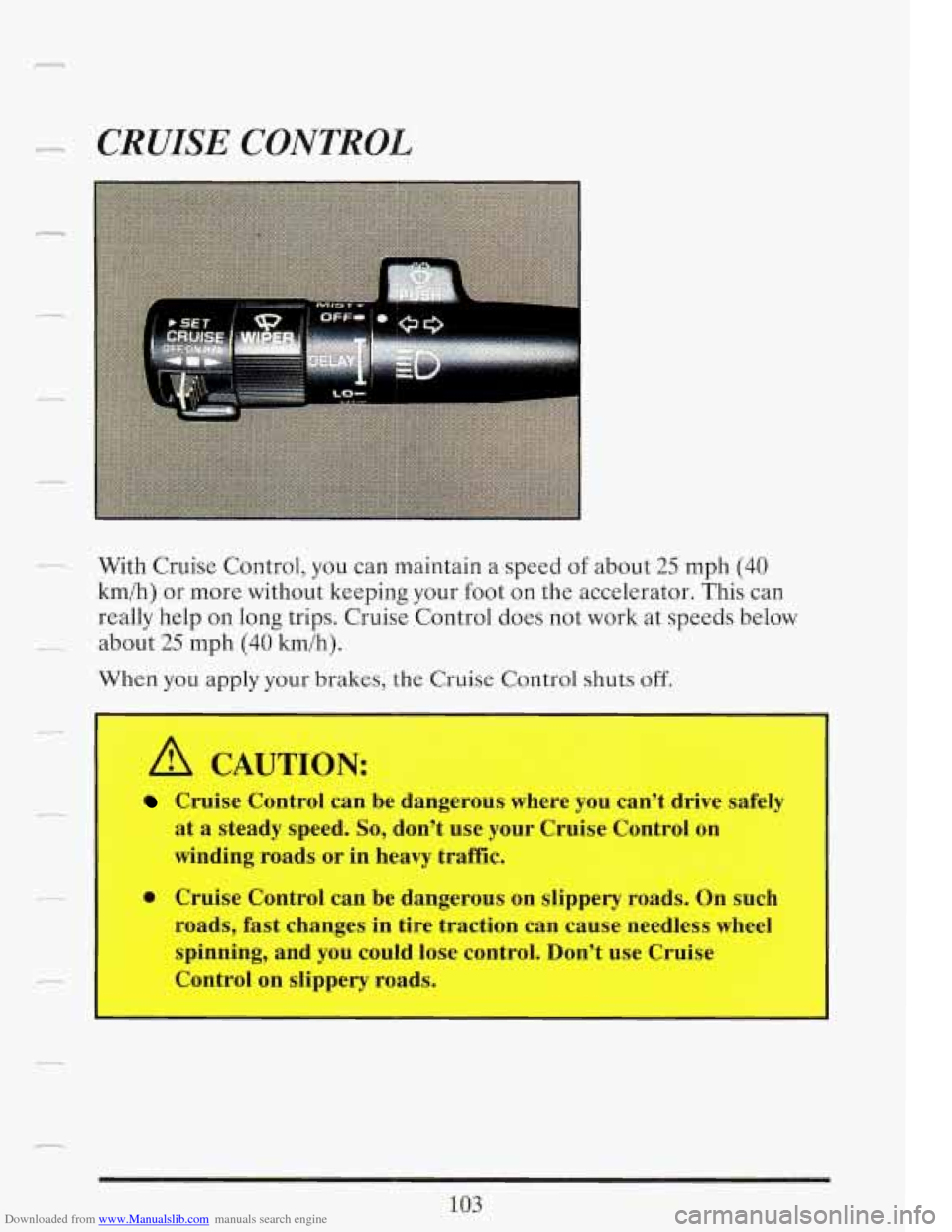
Downloaded from www.Manualslib.com manuals search engine CRUISE CONTROL
With Cruise Control, you can maintain a speed of about 25 mph (40
km/h) or more without keeping your foot on the accelerator. This can
really help
on long trips. Cruise Control does not work at speeds below
about
25 rnph (40 km/h).
When you apply your brakes, the Cruise Control shuts
off.
A CAUTION:
Cruise Control can be dangerous where you can’t drive safely
at a steady speed.
So, don’t use your Cruise Control on
winding roads or in heavy traffic.
0 Cruise Control can be dangerous on slippery roads. On such
roads, fast changes in tire traction can cause needless wheel
spinning, and you could lose control. Don’t use Cruise
Control on slippery roads.
103
Page 188 of 386
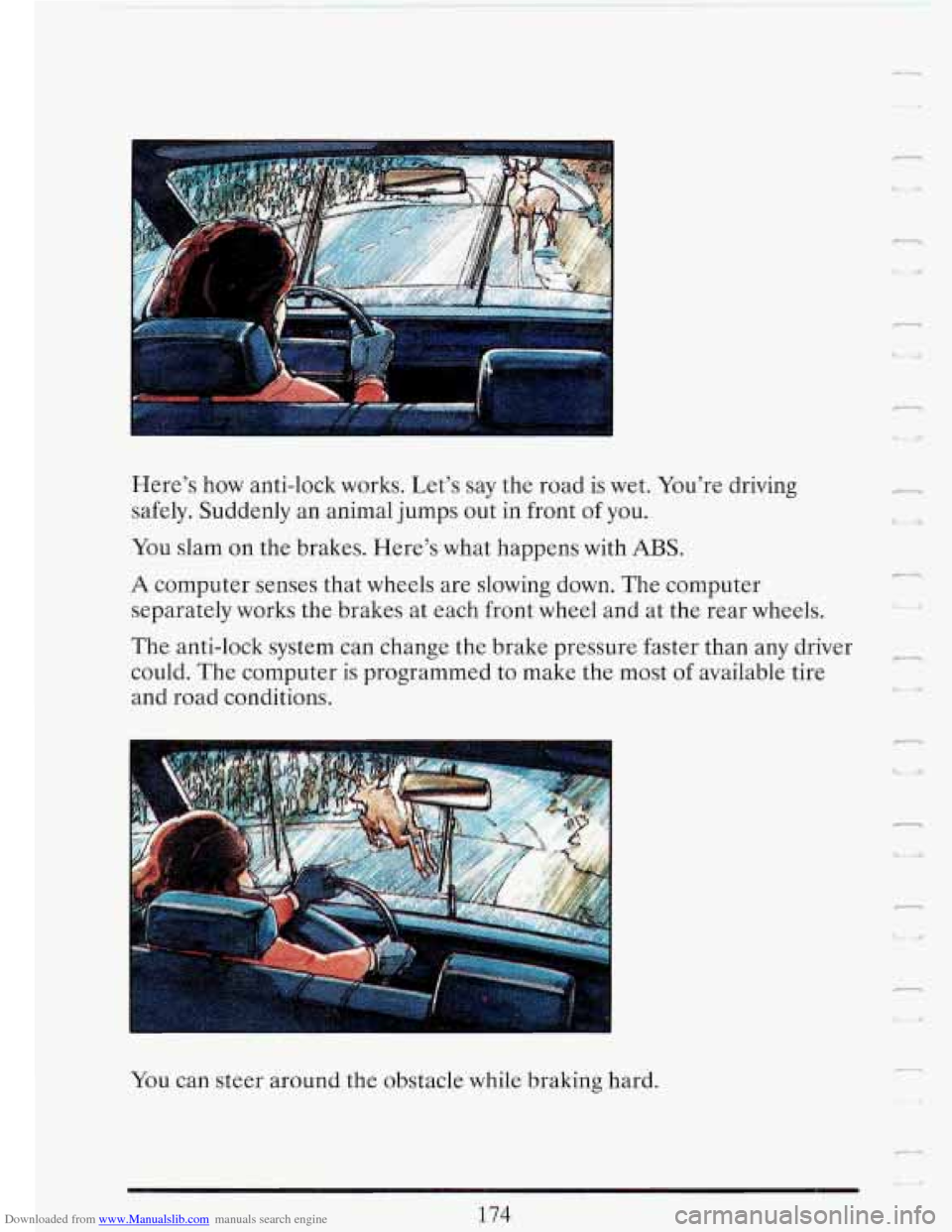
Downloaded from www.Manualslib.com manuals search engine Here’s how anti-lock works. Let’s say the road is wet. You’re driving
safely. Suddenly an animal jumps out in front
of you.
You slam on the brakes. Here’s what happens with
ABS.
A computer senses that wheels are slowing down. The computer
separately works the brakes at each front wheel and at the rear wheels.
c
U
The anti-lock system can change the brake pressure faster than any driver 7 could. The computer
and road conditions. is programmed to make the most of available tire u
n
You can steer around the obstacle while braking hard. .-
L.4
Page 189 of 386

Downloaded from www.Manualslib.com manuals search engine r As you brake, your computer keeps receiving updates on wheel speed and
controls braking pressure accordingly.
r
A CAUTION:
Anti-lock doesn’t change the time you need to get your foot up to
the brake pedal.
If you get too close to the vehicle in front of
you, you won’t have time to apply your brakes if that vehicle
suddenly slows
or stops. Always leave enough room up ahead to
stop, even though you have anti-lock brakes.
To Use Anti-Lock:
Don’t pump the brakes. Just hold the brake pedal down and let anti-lock
feel the brake pedal pulsate, but this is normal.
-- work for you. You may hear the anti-lock pump or motor operate, and
175
Page 193 of 386
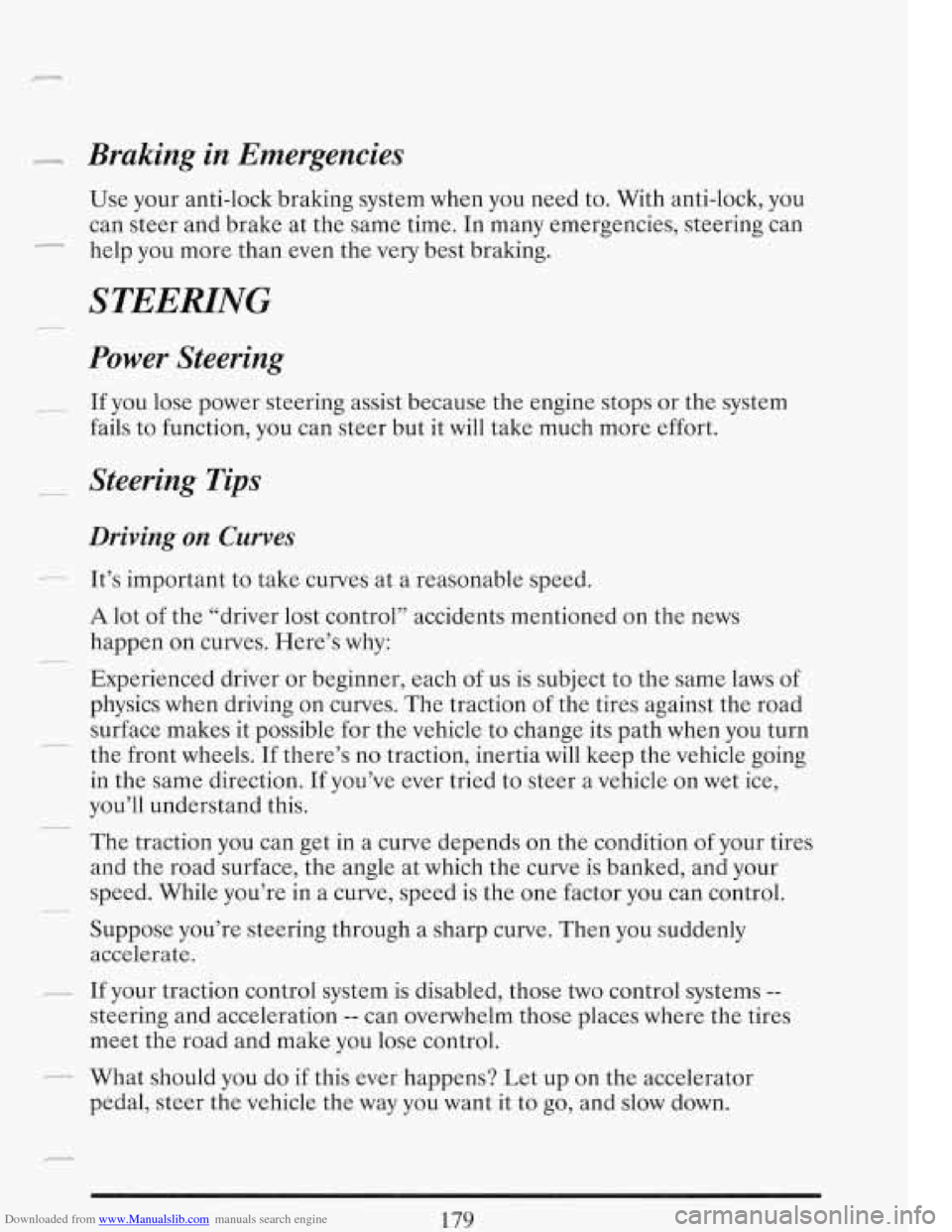
Downloaded from www.Manualslib.com manuals search engine Braking in Emergencies
Use your anti-lock braking system when you need to. With anti-lock, you
can steer and brake at the same time. In many emergencies, steering can
help you more than even the very best braking.
STEERING
Power Steering
If you lose power steering assist because the engine stops or the system
fails to function, you can steer but it will take much more effort.
Steering Tips
Driving on Curves
It’s important to take curves at a reasonable speed.
A lot of the “driver lost control” accidents mentioned on the news
happen on curves. Here’s why:
Experienced driver
or beginner, each of us is subject to the same laws of
physics when driving on curves. The traction
of the tires against the road
surface makes it possible for the vehicle to change its path when you turn
the front wheels. If there’s no traction, inertia
will keep the vehicle going
in the same direction. If you’ve ever tried to steer
a vehicle on wet ice,
you’ll understand this.
The traction you can get in a curve depends on the condition
of your tires
and the road surface, the angle at which the curve is banked, and your
speed. While you’re in a curve, speed is the
one factor you can control.
Suppose you’re steering through a sharp curve. Then you suddenly
accelerate.
If your traction control system
is disabled, those two control systems --
steering and acceleration -- can overwhelm those places where the tires
meet the road and make you lose control.
What should you do if this ever happens? Let up on the accelerator
pedal, steer the vehicle the way you want it to go, and slow down.
179
Page 211 of 386
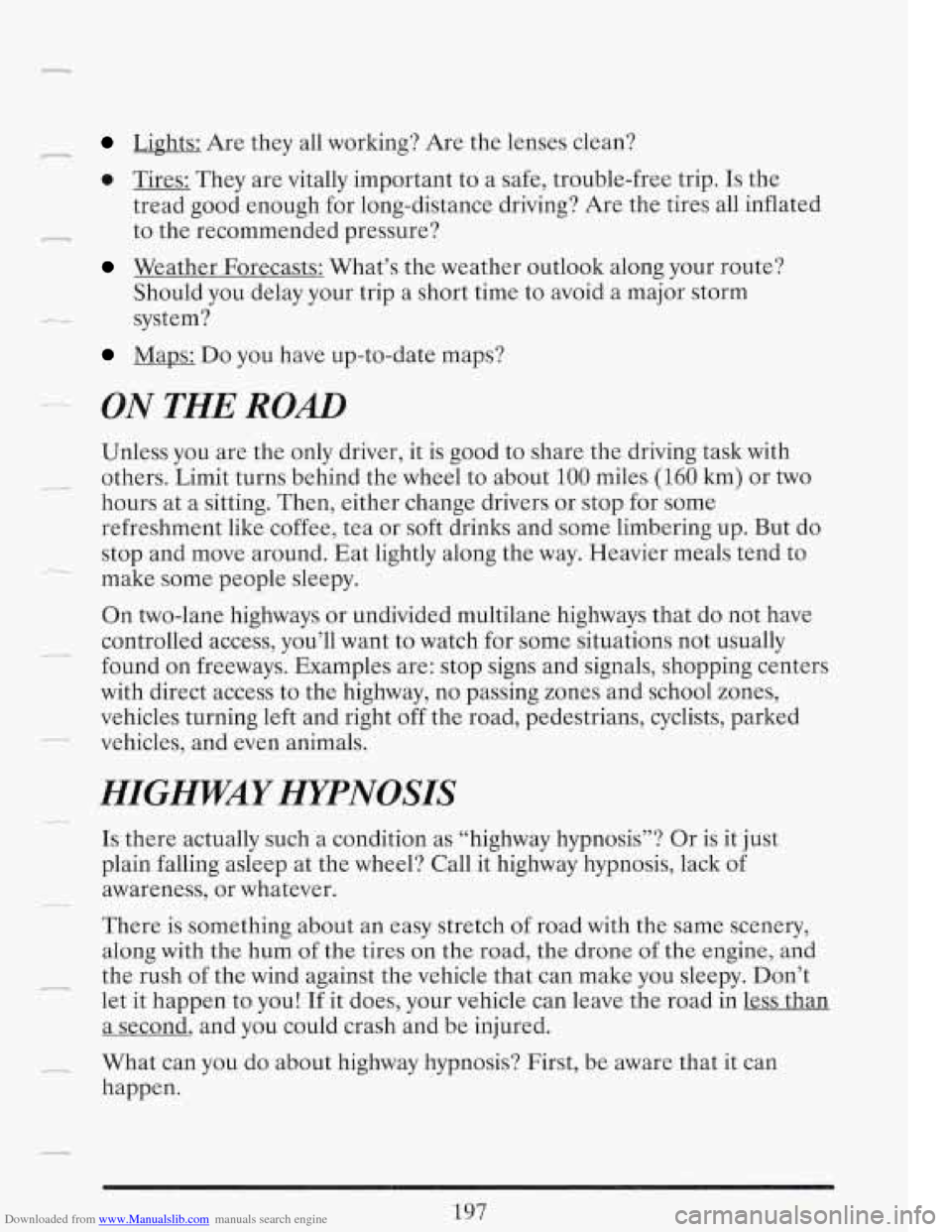
Downloaded from www.Manualslib.com manuals search engine - Lights: Are they all working? Are the lenses clean?
0 Tires: They are vitally important to a safe, trouble-free trip. Is the
tread good enough for long-distance driving? Are the tires all inflated
to the recommended pressure?
Weather Forecasts: What’s the weather outlook along your route?
Should you delay your trip a short time to avoid a major storm
system?
Maps: Do you have up-to-date maps?
_- - ON THE ROAD
Unless you are the only driver, it is good to share the driving task with
hours at a sitting. Then, either change drivers or stop for some
refreshment like coffee, tea or soft drinks and some limbering up. But do
stop and move around. Eat lightly along the way. Heavier meals tend
to
make some people sleepy.
- others. Limit turns behind the wheel to about 100 miles (160 km) or two
- ._
On two-lane highways or undivided multilane highways that do not have
controlled access, you’ll want to watch for some situations not usually
found on freeways. Examples are: stop signs and signals, shopping centers
with direct access to the highway,
no passing zones and school zones,
vehicles turning left and right off the road, pedestrians, cyclists, parked
vehicles, and even animals.
-
-
HIGWAY HYPNOSIS
c_
Is there actually such a condition as “highway hypnosis”? Or is it just
plain falling asleep at the wheel? Call it highway hypnosis, lack
of
awareness, or whatever.
There is something about an easy stretch of road with the same scenery,
along with the hum
of the tires on the road, the drone of the engine, and
- the rush of the wind against the vehicle that can make you sleepy. Don’t
let it happen
to you! If it does, your vehicle can leave the road in less than
a second, and you could crash and be injured.
happen.
__
- What can you do about highway hypnosis? First, be aware that it can
Page 223 of 386
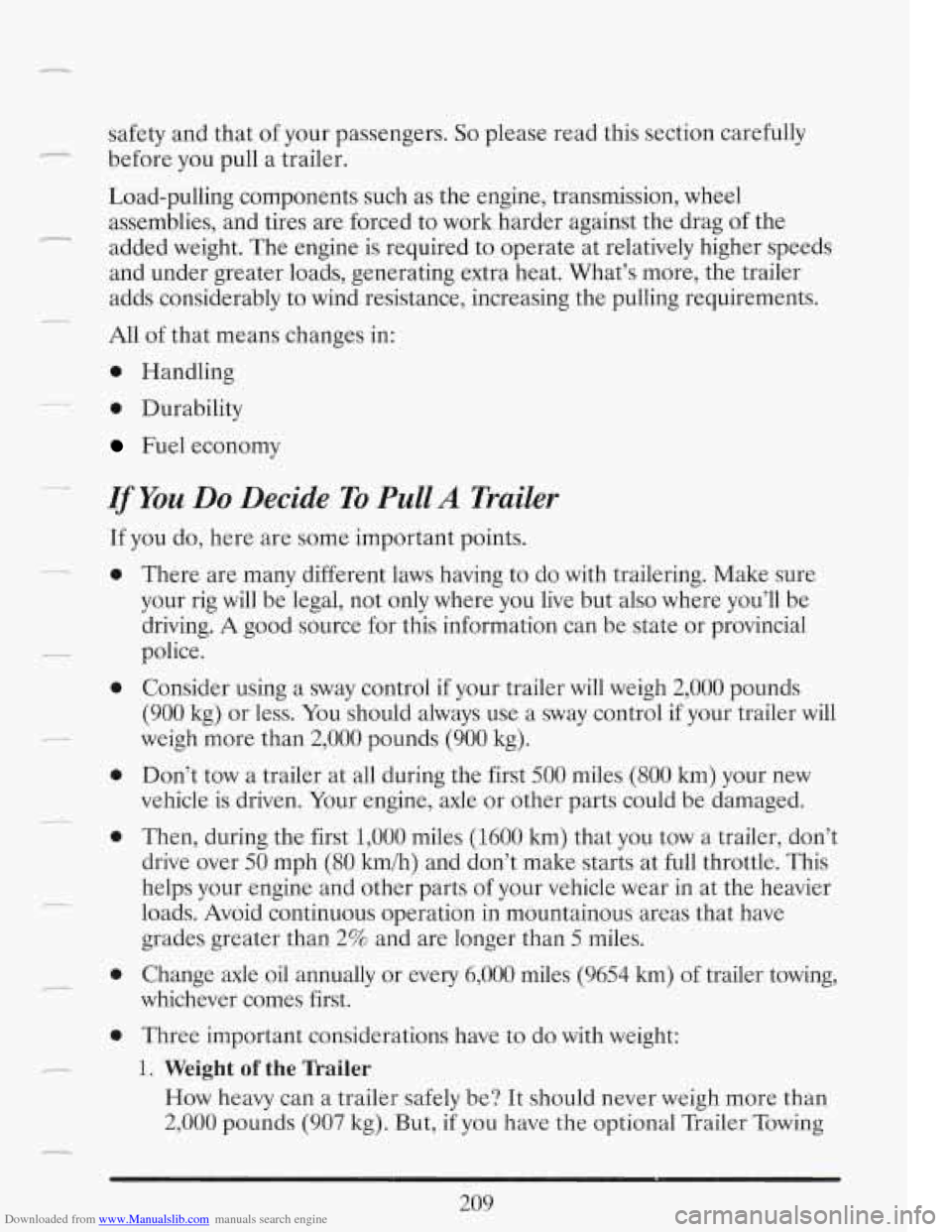
Downloaded from www.Manualslib.com manuals search engine *_
safety and that of your passengers. So please read this section carefully
before you pull a trailer.
Load-pulling components such as the engine, transmission, wheel
assemblies, and tires are forced to work harder against the drag
of the
added weight. The engine is required to operate at relatively higher speeds
and under greater loads, generating extra heat. What’s more, the trailer
adds considerably to wind resistance, increasing the pulling requirements.
All of that means changes in:
0 Handling
0 Durability
Fuel economy
If You Do Decide To Pull A Trailer
If you do, here are some important points.
0
0
0
0
0
0
There are many different laws having to do with trailering. Make sure
your rig will be legal, not only where you live but also where you’ll be
driving.
A good source for this information can be state or provincial
police.
Consider using a sway control if your trailer will weigh
2,000 pounds
(900 kg) or less. You should always use a sway control if your trailer
will
weigh more than 2,000 pounds (900 kg).
Don’t tow a trailer at all during the first 500 miles
(800 km) your new
vehicle is driven. Your engine, axle or other parts could be damaged.
Then, during the first
1,000 miles (1600 km) that you tow a trailer, don’t
drive over
50 mph (80 km/h) and don’t make starts at full throttle. This
helps your engine and other parts of your vehicle wear in at the heavier
loads. Avoid continuous operation
in mountainous areas that have
grades greater than
2% and are longer than 5 miles.
Change axle
oil annually or every 6,000 miles (9654 km) of trailer towing,
whichever comes first.
Three important considerations have to do with weight:
1. Weight of the nailer
How heavy can a trailer safely be? It should never weigh more than
2,000 pounds (907 kg). But, if you have the optional Trailer Towing
Page 227 of 386
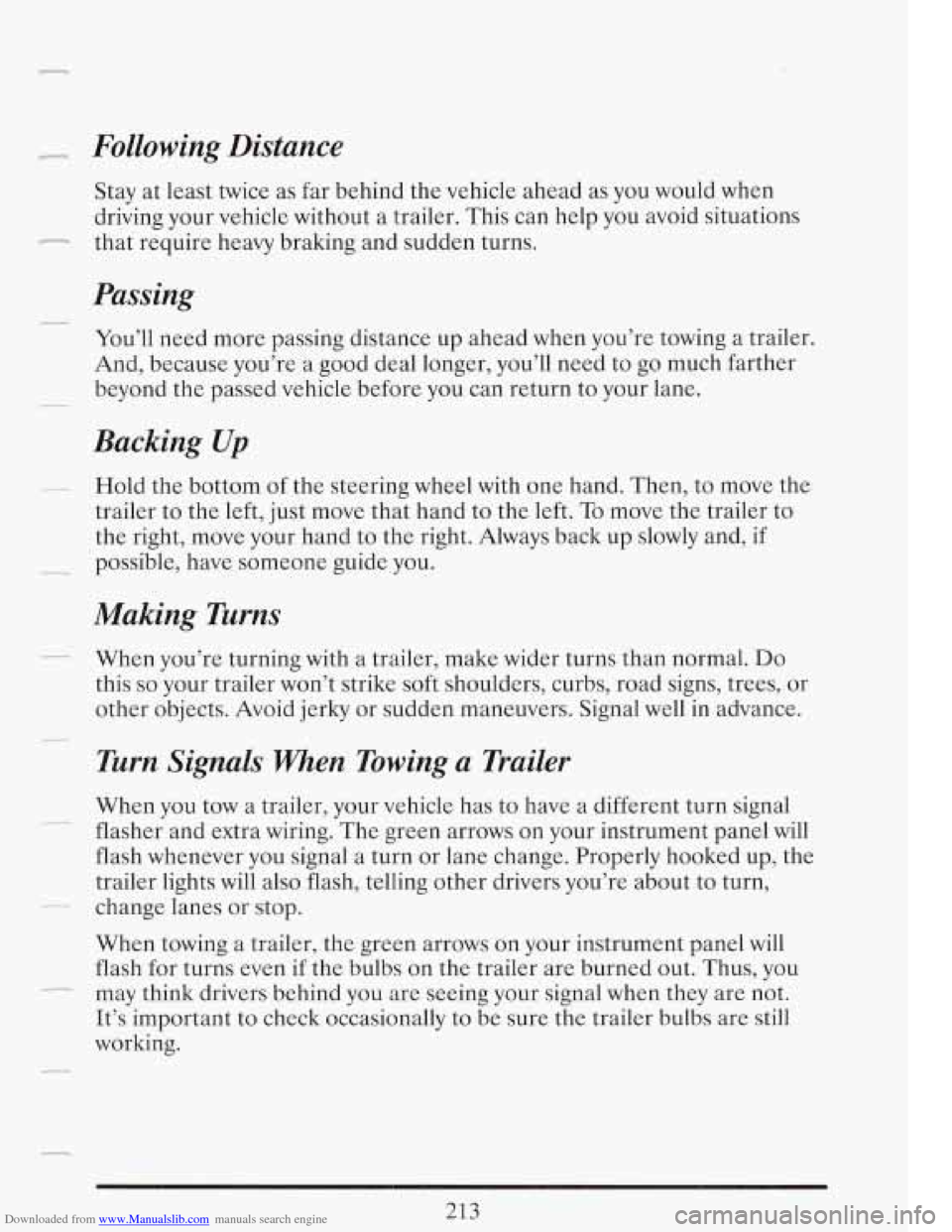
Downloaded from www.Manualslib.com manuals search engine - Following Distance
Stay at least twice as far behind the vehicle ahead as you would when
driving your vehicle without a trailer. This can help you avoid situations
- that require heavy braking and sudden turns.
Passing
I_
You’ll need more passing distance up ahead when you’re towing a trailer.
And, because you’re a good deal longer, you’ll need to go much farther
beyond the passed vehicle before you can return to your lane.
-
Backing Up
_- Hold the bottom of the steering wheel with one hand. Then, to move the
trailer to the left, just move that hand to the left.
To move the trailer to
the right, move your hand
to the right. Always back up slowly and, if
- possible, have someone guide you.
Making Turns
When you’re turning with a trailer, make wider turns than normal. Do
this so your trailer won’t strike soft shoulders, curbs, road signs, trees, or
other objects. Avoid jerky or sudden maneuvers. Signal well in advance.
1urn Signals When Towing a Trailer
When you tow a trailer, your vehicle has to have a different turn signal
flasher and extra wiring. The green arrows on your instrument panel will
flash whenever you signal a turn or lane change. Properly hooked up, the
trailer lights will also flash, telling other drivers you’re about to turn, -
- change lanes or stop.
213
When towing a trailer, the green arrows on your instrument panel will
flash for turns even
if the bulbs on the trailer are burned out. Thus, you
may think drivers behind you are seeing your signal when they are not.
It’s important to check occasionally to be sure the trailer bulbs are still
working. p__-_.
Page 237 of 386
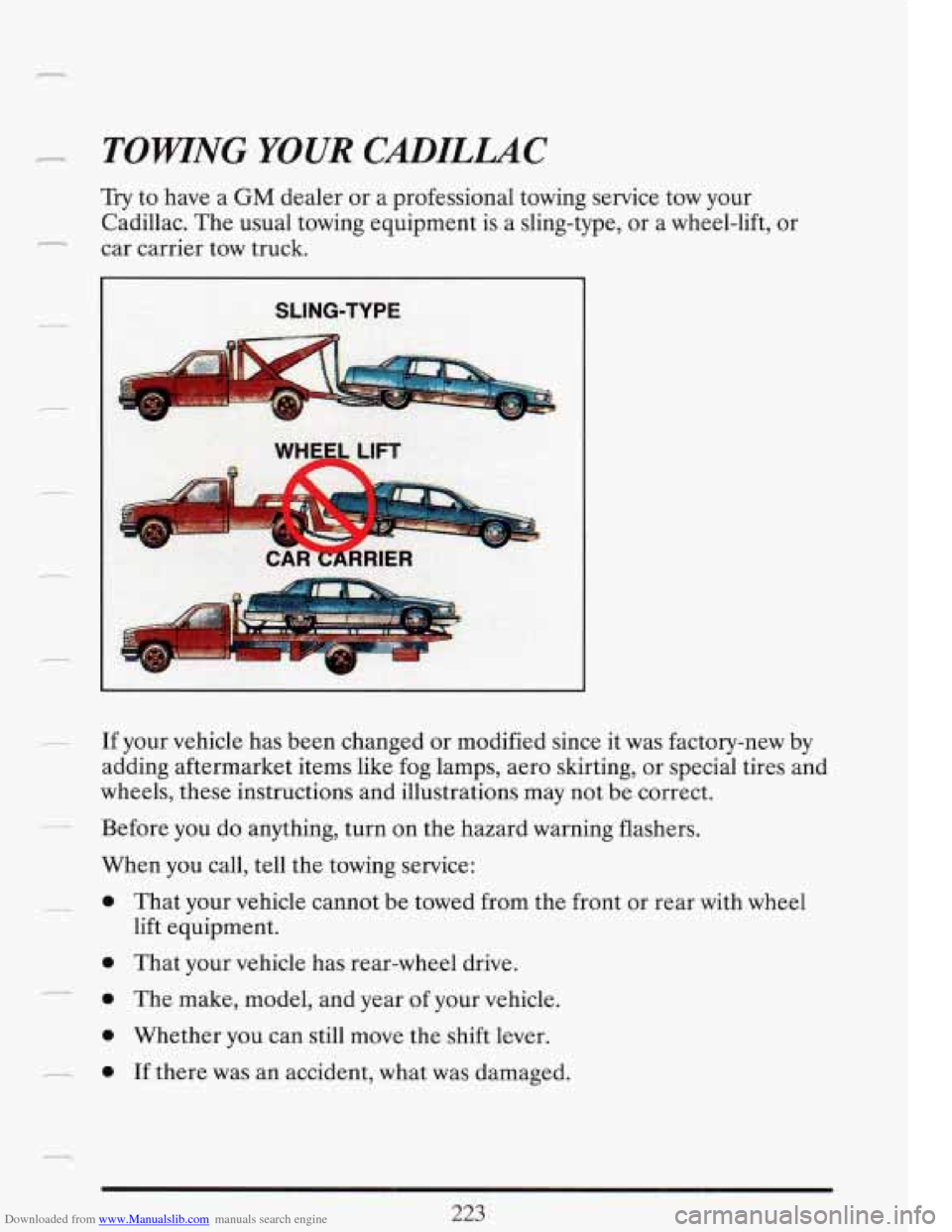
Downloaded from www.Manualslib.com manuals search engine TOWNG YOUR CXDILLAC
Try to have a GM dealer or a professional towing service tow your
Cadillac. The usual towing equipment
is a sling-type, or a wheel-lift, or
car carrier tow truck.
If your vehicle has been changed or modified since it was factory-new by
adding aftermarket items like fog lamps, aero skirting,
or special tires and
wheels, these instructions and illustrations may not be correct.
-- Before you do anything, turn on the hazard warning flashers.
When you call, tell the towing service:
0
0
0
-0
-
That your vehicle cannot be towed from the front or rear with wheel
lift equipment.
That your vehicle has rear-wheel drive.
The make, model, and year
of your vehicle.
Whether you can still move the shift lever.
If there was an accident, what was damaged.
223